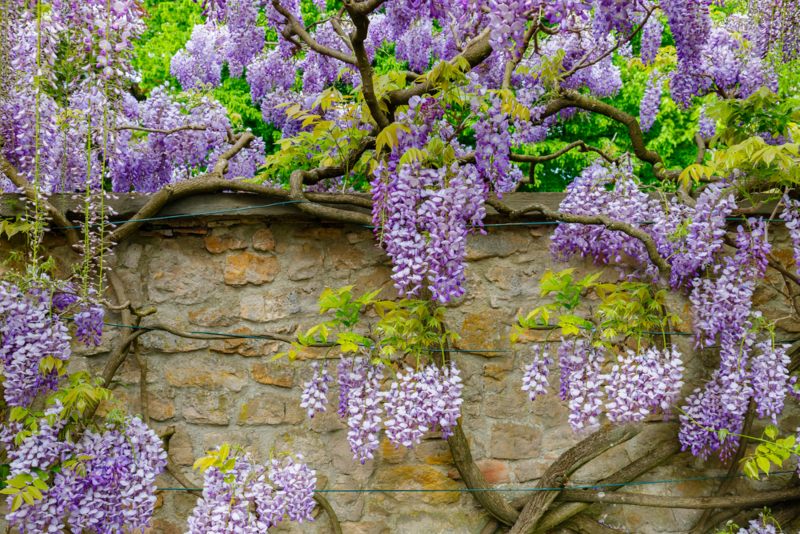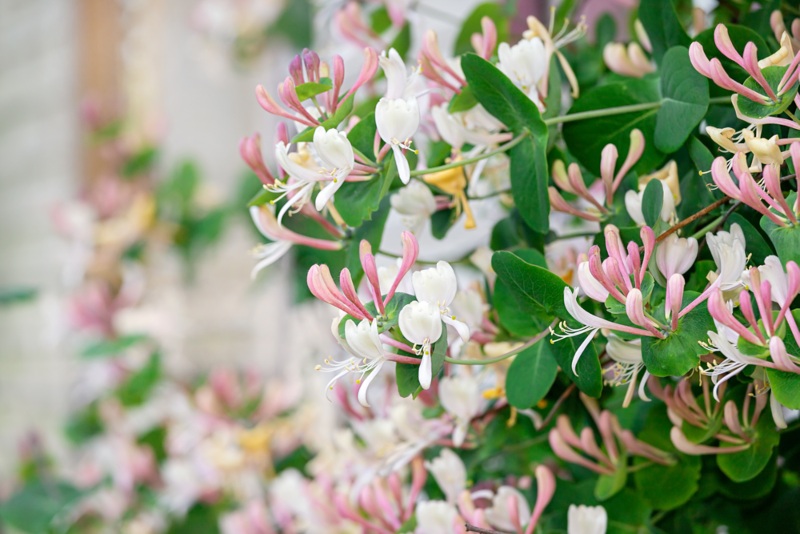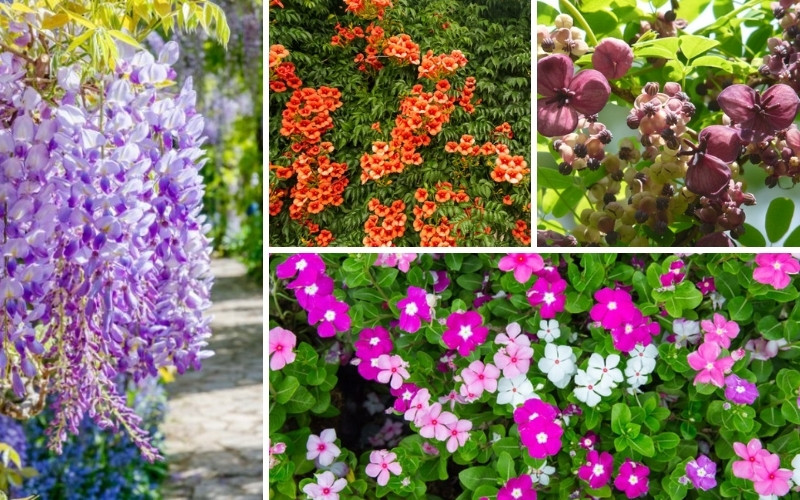
Growing flowering vines in your garden is a great way to save on space, not to mention they offer much-needed shade and privacy.
Most flowering vines are easy to grow, with little to no effort from you, and come in all shapes and sizes, producing colorful blooms that can be grown in hanging baskets or on front porches, pergolas, trellises, and entryways.
While some non-native vines are considered invasive, the following flowering vines can add color and texture to your garden or outdoor space.
Wisteria (Wisteria spp.)

Growing to 10-50 feet tall, Wisteria is one of the most recognizable and well-known flowering vines. They are fast-growing and often seen covering wooden trellises, pergolas, and even on the side of homes.
The Wisteria is most noted for their fragrant, cascading flowers that can range in a variety of colors such as blue, purple, lavender, or white. It is a hardy plant that can easily grow into rocks, cracks, or any crevice they come into contact with, so take caution when planting.
Honeysuckle (Lonicera spp.)

Producing a tube-like, fragrant flower that attracts hummingbirds, butterflies, and other pollinating wildlife, the Honeysuckle is a versatile vine providing much-needed shade and privacy for your garden.
They grow well in full sun or partial shade and thrive on trellises, arbors, and archways. In some areas of the United States, Honeysuckle is known as an invasive plant, growing from 8 – 30 feet tall and requiring constant control.
Cup & Saucer Vine (Cobaea scandens)

Native to Mexico and Peru, this tropical vine gets its name from the tea-cup-like flowers that bloom amid luscious green saucer-like petals. They are easy to grow but sometimes need a little help during the germination stage. Simply soak the seeds overnight to soften the tough outer shell to help the plants sprout.
Commonly called Cathedral Bells, these white or purple blooms are fast-growing and thrive in the full sun. They mostly bloom during the summer to fall season; however, you can move them indoors to enjoy blooms year-round.
Bougainvillea (Bougainvillea spp.)

While the Bougainvillea can be grown as a houseplant or in a hanging basket, it thrives outdoors in warm tropical regions where it has room to spread out. It requires full sun and is quite sensitive to frost, so be sure to plant on higher ground where there is no tendency for water to collect.
The Bougainvillea can grow up to 30 feet tall and blooms nearly year-round with bright pink, orange, red, yellow, or white flowers.
Morning Glory (Ipomoea spp.)

Morning Glories are best known in cottage-style gardens and can be grown on an annual basis even though the flowers only live for one day. They are fast-growing, require full sun, and grow up to 15 feet tall.
Morning Glories are recognized by their large heart-shaped leaves and funnel-shaped flowers that come in purple, blue, pink, white, or bicolor.
Passionflower (Passiflora spp.)

Give your garden a tropical flair with the multicolored Passion Flower. These plants grow well in USDA Hardiness zones 5-11 and require full sun to partial shade. They can grow from 6-30 feet tall and bloom from summer to fall.
The Passion Flower can be invasive in warmer regions, so make sure to research if this vine will do well in your area.
Trumpet Vine (Campsis radicans)

Also known as a Trumpet Creeper, the Trumpet Vine is a high climbing woody vine that needs regular pruning to keep under control. It requires full sun to partial shade and can grow up to 40 feet tall. You will find Trumpet Vines do best when choosing a suitable place to grow to support its heavy structure.
Clematis (Clematis spp.)

Producing flowers of different colors and sizes, the Clematis is an evergreen plant that primarily blooms in the early spring to fall season. When not in bloom, the leaves stay lush and green allowing for great ground cover. It thrives in warm climates and can grow from 2-50 feet tall.
Black-Eyed Susan Vine (Thunbergia alata)

The Black Eyed Susan Vine sometimes gets a bad wrap, mistakenly being considered a wildflower. Producing a 5-petal flower ranging in colors of yellow, orange, and apricot with their notable dark center, these cheerful, colorful flowers are sure to add a smile to everyone’s face.
Most known to be great pollinators, the Black-Eyed Susan Vine requires full sun to partial shade, does well in zones 10-11, and blooms from late summer to fall. When all other blooms stop flowering, the Black-Eyed Susan lights the way in any home garden.
Mandevilla (Mandevilla spp.)

The Mandevilla is popular in southern Florida due to the warm climates. It can be grown as an annual and requires full sun to partial shade. The trumpet-shaped flowers come in a variety of colors, including red, pink, white, or apricot.
Blooming in the summer through the fall, the Mandevilla can be grown in a hanging basket, trellis, entryway, or post. Great for sprucing up your outdoor space.
Moonflower (Ipomoea alba)

This gorgeous perennial vine flourishes in subtropical regions and is adaptable to all types of soil conditions. The Moon Flower is deserving of its name due to the white (or sometimes purple) flowers only opening in the late afternoon and evening.
It thrives in zones 10-11 and can be grown as an annual if brought indoors during the cooler months.
Sweet Pea (Lathyrus odoratus)

Known for its pea-like blooms of pink, red, lavender, blue, orange, yellow, or bicolor, the Sweet Pea vine actually prefers cooler climates. Growing from 4 to 8 feet tall, this vine requires full sun to partial shade or can be grown on an annual basis.
It will bloom from late winter to early spring in warmer climates, and during the cooler months, it will bloom from late spring to fall.
Star Jasmine (Trachelospermum jasminoides)

Producing fragrant white star-shaped flowers, the Star Jasmine is perfect for any home garden. It grows well in USDA Hardiness Zones 8-10, requires full sun to partial shade, and can get up to 20 feet tall.
The Star Jasmine is a fast-growing, hardy vine that needs support for its weight. Be sure to stabilize the trellis or pergola before planting.
Climbing Hydrangea (Hydrangea anomala subsp. petiolaris)

If shade and privacy are what you’re looking for, then the Climbing Hydrangea is the perfect flowering vine for you. It is the lesser-known of the Hydrangea plants (which are most notably known as shrubs) but can grow from 30 to 50 feet tall.
This vine requires full sun to partial shade and is most suitable for woodland gardens. The white flowers bloom from late spring to mid-summer, offering many benefits, including cooling your home due to its vigorous growth coverage.
The Climbing Hydrangea is a hardy plant that can often attach itself to any structure.
Scarlet Runner Bean (Phaseolus coccineus)

Closely related to the green bean, this fast-growing annual vine was once a constant staple in the early American food garden. Today, you will find this flowering vine growing its ornamental flowers to attract birds, bees, and butterflies.
Prosperous in zones 7-11, the Scarlet Runner Bean produces flowers ranging in colors such as red, pink, white, or bicolor. The pod and bean are edible.













